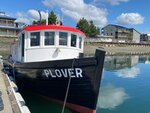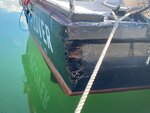

The city of Blaine announced August 23 that it ran into difficulty operating the Plover and would not start operations as previously anticipated. The city stated ferry service would remain suspended until further notice.
The city made the announcement one day before ferry service was supposed to begin August 24, which was highly anticipated after the vessel had undergone nearly two years of repair work. The Plover was expected to start earlier in the summer but was delayed due to final repairs and then a financial dispute with Drayton Harbor Maritime (DHM), contracted by the city to conduct repair work and the nonprofit that has historically operated the Plover.
The city announcement read, “We ask for your patience as we navigate through some other issues. Rest assured, we’re working tirelessly to resolve these as soon as possible.”
City manager Mike Harmon said during the August 26 Blaine City Council meeting that a plate over the corner of the stern fell off on August 25 due to rot behind it. This happened while the Plover crew was undergoing required training, he said, adding that a U.S. Coast Guard structural inspector was scheduled to look at the boat August 28.
“It’s likely that we’re seeing only the beginning of the rot, and there’s likely more rot,” Harmon said. “Plans will be made once we know the extent of the rot on the stern of the Plover.”
The Plover captains said water would enter the boat if they operated the vessel, Harmon said.
Council member Richard May asked city staff if they knew what percentage of the Plover was replaced by new material during the most recent repair, to which Harmon said they didn’t know.
The U.S. Coast Guard had inspected the Plover repairs earlier this summer, but was unaware of the rot. Repairs were done to the keel and bow, but not to the stern, Harmon said.
“When we were talking about the additional cost for the Plover, I was asked if this would be the last time we would spend money, I promised it wouldn’t be,” Harmon said. “This is an old wooden boat and it’s always going to be something.”
The city has spent about $130,000 on the Plover repairs over nearly the past two years. May said the amount of money the city has spent on the repairs is a higher amount than the city would need to purchase a boat of the same size.
“I hope we think very carefully what our next steps are because we now have a sunk cost,” May said. “So much of this boat has been fixed, will just a little bit more money make it completely fixed? And we have to identify whether or not what we should have done two years ago was to buy a similar boat in good condition for about half as much money, paint it and call it the new Plover. That may have been something we should have considered then, but now all we have is bad options.”
Sonia Hurt commended DHM and its executive director Richard Sturgill for nearly three decades of service to the Plover. Hurt said Sturgill has decided to officially retire, and both he and DHM will no longer be associated with the Plover.
Blaine City Council accepted the work completed on the Plover and closed the contract during its meeting.
1 comment on this item Please log in to comment by clicking here
MeanUncle
$130,000 for repairs? But wait, isn't the contract for more than just repairs? Also, please review the length of time the money was spent. This is a historic commercial vessel that must meet Coast Guard standards. Despite what some people might say, you don't just buy a boat like the Plover. The Plover is a tourist attraction that draws people to our downtown and waterfront, helping our local economy grow.
The typical annual salary of the shipwright is $65,000; I am pretty sure the Plover was not a one-person job. If you are lucky, a US Coast Guard Certified Boat Captain might be as little as $30,000 (per season). You still need a Seasonal Deckhand to help, which will run you at least $10,000.00 (per season). It would be a completely different story if these are considered union jobs.
While I don't have the exact Plover story, this is an example of what happens to old wooden boats when they're taken out of the water for repairs.
When an old wooden boat is taken out of salt water and left exposed to the elements for two years, it quickly begins to degrade in ways that are both visible and hidden beneath the surface. As the wood dries, it shrinks, cracks, and splits, exposing vulnerable seams and joints. The drying process, combined with rain and fluctuating temperatures, creates the perfect environment for rot to set in, often in places not immediately visible. Dry rot, a silent but relentless destroyer, can take hold deep within the wood, spreading unseen and compromising the boat’s structural integrity long before any external signs become apparent. Meanwhile, moisture trapped in shaded or enclosed areas fosters mold and mildew, accelerating the wood's decay.
The boat’s protective layers of paint and varnish deteriorate rapidly under intense UV exposure, peeling away to reveal the bare wood beneath. Without this protective barrier, the wood weathers and darkens, becoming more susceptible to the effects of water and wind. Once safeguarded by salt water’s preservative properties, metal components corrode quickly in the open air. Rust eats away at fasteners, fittings, and structural elements, making them prone to failure. Galvanized parts lose their coating, and even brass fixtures begin to show signs of oxidation. This hidden corrosion weakens critical components, while ropes, fabrics, and leather exposed to sun and rain stiffen, crack, and deteriorate beyond repair.
Saturday, August 31 Report this